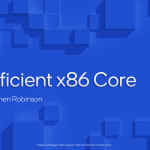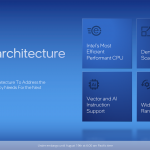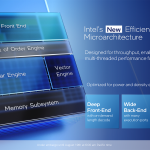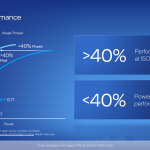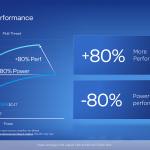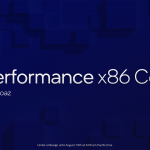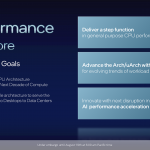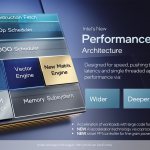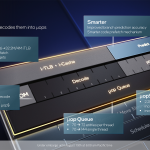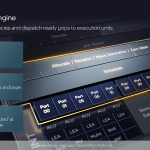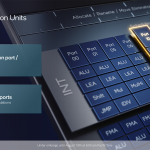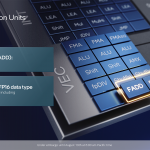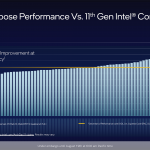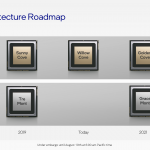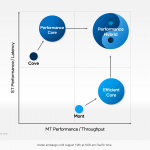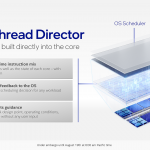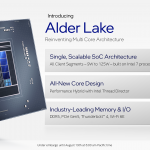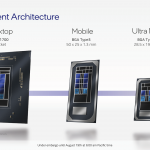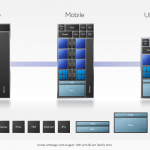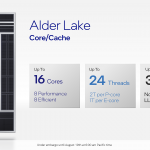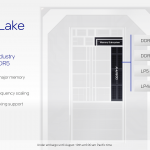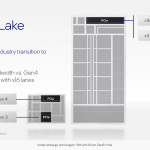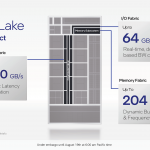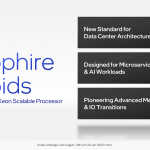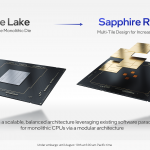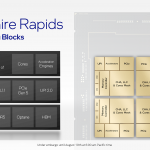Intel has confirmed details on its upcoming processor technologies at its Architecture Day 2021. Many of the key points we already knew via various leaks, however, we now have full confirmation of these new technologies and the upcoming product specifications.
One of the key new features that Intel is introducing is the ‘efficient core’ design. This is optimised for power and density efficient throughput, according to Intel. There’s a 64KB instruction cache alongside the branch predictor and dual three-wide out of order decoders. The key takeaway from these initial design traits is the focus on power efficient performance on the desktop – an area where Intel has really struggled in recent history with its 14nm-class processors.
In terms of memory subsystem in the efficient core, there is up to 4MB of L2 cache shared among four cores with 64 Bytes per cycle bandwidth in 17 cycles of latency. And Intel continues to highlight its inclusion of advanced instruction sets, including design points relating to Vector Neural Network Instructions (VNNI).
Using Skylake core as a comparison point, Intel is highlighting latency and throughout power and performance gains – simultaneously – on both a 1C1T basis and also with the new 4C4T Efficient core going up against 2C4T of Skylake architecture.
Of course, Intel is making desktop/laptop/data centre processors in some configurations. So, while efficient and strong low power usage is important, the ability to offer high levels of x86 performance is critical. That is where Intel highlights the ‘Performance’ x86 core – with one of its goals to ‘deliver a step function in general purpose CPU performance’.
According to Intel, the Performance x86 Core ‘deigned for speed, pushing the limits of low latency and single threaded application performance via Wider, Deeper, Smarter’. That point relating to single threaded application performance is interesting, we will have to wait and see what this means for multi-threaded performance.
One notable point, however, is the FMA units supporting FP16 data types. FP16 is added Intel AVX512, and this is notable because AMD does not currently support AVX512 instruction sets like Intel does. That is perhaps more important for data centre use cases, despite Intel’s attempts to show off AVX512-infused AI acceleration on its Tiger Lake and the likes laptop processors with specific supported software (that has had heavy Intel involvement).
According to the roadmap, the architecture technologies to be used in Alder Lake – Golden Cove and Gracemont – are still scheduled for 2021 release. So, we should expect to see these in the coming months.
Intel Thread Director is a scheduling tool built directly into the Intel core. This looks to be similar to what we have heard from Microsoft for Windows 11 and Intel did highlight in the presentation that they partnered with Microsoft for some of the work with relation to Windows 11 use cases.
The scheduling of background and foreground tasks on the Performance cores or the Efficient cores is a smart move. Higher priority – foreground tasks – can utilise the higher horsepower, more energy expensive cores, while the lower priority – background tasks – can run on the lesser performing but more power friendly Efficient cores.
It will be interesting to see more details on this as the processors release and the use cases can be examined more closely.
Now for confirmation from Intel relating to the upcoming Alder Lake processor family.
This ‘Single, Scalable SoC Architecture’ will span all client segments – from 9W to 125W – and is built on the newly named Intel 7 process. The core design is a hybrid approach – utilising Efficient cores and Performance cores – and Intel Thread Director is included.
And in terms of platform capabilities, this looks to be on particular area where Alder Lake will be strong. This new LGA 1700 socket processor will be the first consumer desktop platform to feature support for DDR5 memory and PCIe Gen 5. And Intel also highlights Thunderbolt 4 and Wi-Fi 6E support, though they will also be at motherboard manufacturer discretion for the desktop parts.
Intel’s building blocks approach looks to be designed to adjust the processors based on their use cases. This is not too dissimilar to what we already see. For example, desktop Alder Lake chips may have lesser focus on iGPU performance, but more CPU Performance cores. While some Mobile chips may trade CPU Performance cores for a large slice of iGPU silicon.
Notably, Alder Lake will scale up to 16 total cores but that is split as 8 Performance cores and 8 Efficient cores. The Performance cores support Hyperthreading, but the Efficient cores do not. So this is up to a 16 Performance thread plus 8 Efficient thread design.
Memory support is vast with Alder Lake. Conventional DDR4-3200 and DDR5-4800 will be supported alongside LPDDR5-5200 and LPDDR4x-4266. Being the first mainstream platform to adopt DDR5 could give Alder Lake some inherent advantages, especially in the domain of integrated GPU performance.
And support for PCIe Gen 5 is another clear victory for Intel, with the new interconnect doubling bandwidth versus Gen 4. Though this may seem a little unnecessary currently – especially for graphics cards – on the SSD front, it did not take long for ultra-high-speed Gen 4 devices to pop up for mainstream consumers. So we can only hope that even higher performance SSDs utilising PCIe Gen 5 are on the horizon now that there is a mainstream platform to support them.
Intel is also highlighting some pretty loft interconnect bandwidth numbers for Alder Lake. The Compute Fabric – which looks to be translating data between the CPU cores – is rated as up to 1000GB/s with dynamic latency optimisation. And the IO Fabric’s up to 64GB/s perhaps spells a greater focus on ensure ample connectivity between the CPU and partnering platform expansion devices. Memory is rated as up to 204GB/s.
Once again, Intel is highlighting Alder Lake for Autumn 2021, so we are expecting to see more information and more precise launch dates very soon. The desktop processors will sit on a new LGA 1700 socket, so that means new motherboards. We have already seen some CPU cooler manufacturers bringing out new socket support kits for their cooling hardware.
Looking briefly at Intel’s new Sapphire Rapids Xeon Scalable processor for data centre usage, Intel has opted for a multi-tile design to increase product scalability. This is – in essence – what AMD does with its chiplet approach for the Zen silicon found in EPYC data centre processors. Though Intel’s implementation looks to be very different, with each tile having its own full set of resources, as opposed to the centralised IO die approach that AMD has used for Zen 2 and Zen 3 EPYC.
Putting the new compute performance and technologies aside, Sapphire Rapids highlights support for PCIe Gen 5 and DDR5. This could be particularly notable for the data centre, especially when AMD’s competing offerings do not offer either of those technologies.
KitGuru says: Alder Lake is just around the corner and should introduce desktop enthusiasts to new technologies such as DDR5 and PCIe Gen 5. Are you excited for the new processors?
 KitGuru KitGuru.net – Tech News | Hardware News | Hardware Reviews | IOS | Mobile | Gaming | Graphics Cards
KitGuru KitGuru.net – Tech News | Hardware News | Hardware Reviews | IOS | Mobile | Gaming | Graphics Cards


